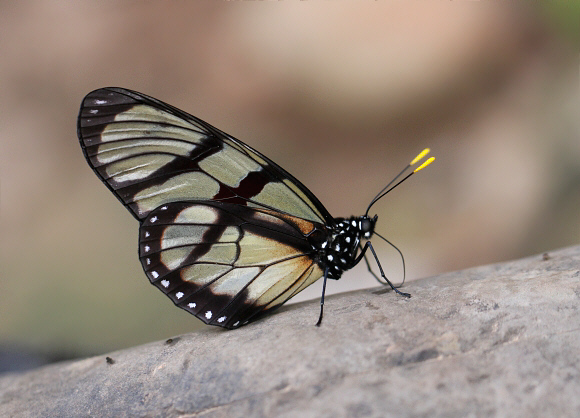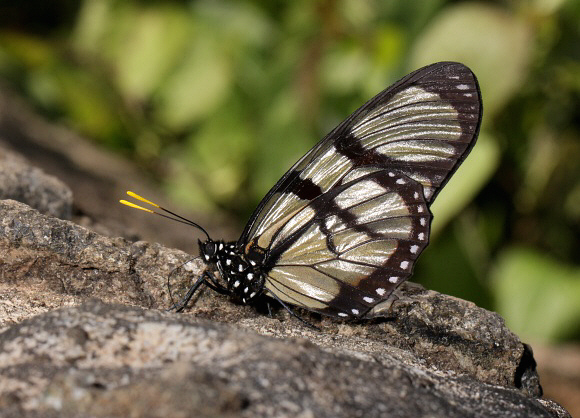 Lycorea ilione phenarete, Rio Shima, Satipo, Peru – Adrian Hoskins
Lycorea ilione phenarete, Rio Shima, Satipo, Peru – Adrian Hoskins
Introduction
The subfamily Danainae has members on all continents, including the Monarch Danaus plexippus, the Euploea Crows of south-east Asia and the Tirumala Blue Tigers of Africa. In the neotropics they are represented by 376 species in the tribe Ithomiini, 5 in the Danaini, and 8 in the Euploeini. The latter tribe includes 3 neotropical genera – Anetia, Archaeolycorea and Lycorea.
There are 3 Lycorea species, namely halia, ilione and pasinuntia. All are largish, strongly marked butterflies with rounded wings and cream-tipped antennae.
In common with other Danaines, the bodies of Lycorea larvae and adults contain toxins that cause vomiting and nausea in any bird that attempts to eat them. Studies have shown that birds are able to remember the strong patterns of these unpalateable butterflies, and to associate them with pain or discomfort. The result is that any bird which has tasted a Lycorea species quickly learns to avoid eating any other species with a similar pattern including toxic Ithomiines in the genera Thyridia and Methona, and the palatable Dismorphiine Patia orise.
Lycorea ilione, ( previously known as Ituna phenarete ) is a widespread species, found from Mexico to Bolivia. The illustrated subspecies Lycorea ilione phenarete is restricted to Peru.
 Lycorea ilione phenarete, Rio Shima, Satipo, Peru – Adrian Hoskins
Lycorea ilione phenarete, Rio Shima, Satipo, Peru – Adrian Hoskins
Habitats
This species occurs in mid-elevation transitional rainforest / cloudforest at altitudes between about 500-1500m. Subspecies phenarete is confined to the foothills of the eastern Andes in Peru.
Lifecycle
The eggs are white. They are laid singly on the underside of Ficus leaves ( Moraceae ). The young larvae nibble rings into the leaf tissue to cut off the plants defensive toxins before eating the area enclosed within the ring. Older larvae bite through the veins causing the toxins to bleed out before eating. The fully grown larvae are white, with narrow black rings around each segment. They have a pair of motile black filaments behind the head, which probably serve to ward off parasitoids. The pupae are pale green and barrel shaped, with compressed abdominal segments. They are formed hanging from leaves or stems of the foodplant.
Adult behaviour
Males are encountered mainly in the early morning when they descend from the canopy to imbibe mineralised moisture from river beaches, boulders, stony tracks etc. When temperatures are low they bask with their wings fully outspread, but in hot weather they are held erect. Males are also attracted to Senecio, Eupatorium and Neomiranda flowers from which they sequester pyrrolizidine alkaloids that are used for chemical defence, and are passed to females during copulation.

Lycorea ilione phenarete, Rio Shima, Satipo, Peru – Adrian Hoskins
